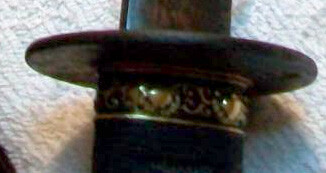-
Posts
5,215 -
Joined
-
Last visited
-
Days Won
140
Content Type
Profiles
Forums
Events
Store
Downloads
Gallery
Everything posted by Ray Singer
-
Thank you Arnold, appreciate the insight on this!
-
I am curious if anyone has thoughts on this sayagaki, referring to the sword as being the first Juho Token. http://www.aoijapan.com/katana-mumei-tegai-7 My assumption is that this is the first (or one of the first) swords appraised by the JTK. I have emailed Aoi but have not received a clear answer on this. Best regards, Ray
-
I would agree with the comments that this appears to be an authentic sword, an osuriage mumei wakizashi. I am struggling to understand what is on the fuchi and kashira. With a bit of adjustment in Photoshop you can see the karakusa pattern, but the objects on top look equal parts Peony and Crab. Suggestions for the mon on the menuki below. It would be great to see better, in focus photos of the sword and fittings. The menuki appear to consist of 3 mon placed on an elongated tablet shape, which is odd. The habaki also appears wrong to my eyes.
-

Not Sure It Is Possible To Translate.
Ray Singer replied to LostDutchman's topic in Translation Assistance
My guess on the blade is Fujiwara Kanemune. Best regards, Ray -

Shin Gunto. The Signature On The Nakago.
Ray Singer replied to Fumei's topic in Military Swords of Japan
It does not appear to be a ka-mon. Rather, I believe it is a family name. -

Shin Gunto. The Signature On The Nakago.
Ray Singer replied to Fumei's topic in Military Swords of Japan
坂倉言之進照包 - Sakakura Gonnoshin Terukane The signature of a well-known, jojo saku smith who had the earlier mei of Echigo (no) Kami Kanesada. Best regards, Ray -

Additional Swords And Fittings For Sale
Ray Singer replied to Ray Singer's topic in Auctions and Online Sales or Sellers
Additional photos and information have been added to my Facebook page at the link below. I was unaware before, but the Kanetoki tanto was featured in John Slough's reference on Gendaito, with a full length oshigata. https://www.facebook.com/Swordsofjapan/ Please 'Like' the page to receive further updates. Best regards, Ray -

Additional Swords And Fittings For Sale
Ray Singer replied to Ray Singer's topic in Auctions and Online Sales or Sellers
Please see below for new pieces for I have listed on my website. AIZU KANESADA An flawless katana in polish and papered to Aizu Kanesada circa Genroku (1688) in original koshirae. $4,800 (plus shipping & pp) http://swordsofjapan.com/project/genroku-period-aizu-kanesada-in-fantastic-koshirae/ YAMATO-DEN KEN A Yamato-style ken from the Edo period in shirasaya. Flawless, in polish with a mukansa quality habaki. $1,600 (plus shipping & pp) http://swordsofjapan.com/project/edo-period-yamato-ken/ NAGINATANAOSHI WAKIZASHI A massive and flawless koto naginatanaoshi, in shirasaya with 2-piece gold wash habaki. Spectacular hamon in nie-deki $1,800 (plus shipping & pp) http://swordsofjapan.com/project/naginatanaoshi-wakizashi-in-shirasaya/ ZENNOSUKE KATO JUMYO A large and wide gendaito by Kato Jumyo, the teacher of Kato Kanefusa. In original kai-gunto koshirae. $1,500 (plus shipping & pp) http://swordsofjapan.com/project/gendaito-katana-by-zennosuke-kato-jumyo-in-kai-gunto-koshirae/ MINO KANETOKI GENDAI TANTO Exellent quality signed and dated gendai tanto by the famous Kojima Kanemichi. Kanetoki was his shomei (first signature). From the Zenjo Kaneyoshi school. $2,000 (plus shipping & pp) Additional pieces available at: http://swordsofjapan.com/home/gallery/ Best regards, Ray -

Mei Help, Yoshimitsu Mashup :)
Ray Singer replied to Salvatori Moretto's topic in Translation Assistance
I share Jean's concern about the viability of restoring this sword. It seems to be largely composed of loose hada with numerous kitae ware (at least from what can be seen in the photo). Very tired, of poor quality or both. Best regards, -

Ogi-Ba (Fan Shaped Hamon) In Masamune Swords
Ray Singer replied to Wah's topic in General Nihonto Related Discussion
Hi Stephen, I spoke with Adrian, who said that it is mostly likely the Kuki Masamune (九鬼正宗) you are referring to. Best regards, Ray -
Jacques, in response to your private message the nakago would have been reduced for the same reason that most of these earlier naginata we see were modified. They were adjusted to be used as daito or wakizashi.
-
Jacques, if you would like to continue the discussion about why you believe the Katayama Ichimonji is ubu please do so here rather that sending me private messages. I stand by my earlier comment that the evidence shows that the nakago has been modified and is not what you would expect to see from an ubu mid-Kamakura nakago. If you look at the oshigata, the lowest part of the hamon shown is a continuation of the same saka-choji, and not what you would see from a hamon that ends naturally at the hamachi. In their photo it also appears that there is some continuation of the hamon into the nakago, even if it is not as clear as what is above the hamachi. I am not referring to the hadori work. When a sword is made suriage, heat is applied to soften the hamon and make the process easier. If I am seeing correctly, it appears that there is a trace of the hamon below what is shown in the oshigata. I have attached an image with the levels adjusted.
-
島田住源義助 Shimada ju Minamoto Yoshisuke.
-
There are individuals such as Mike Yamasaki (tetsugendo.com) and Bob Benson (togishi.com) who can handle the process of bringing your sword to Tanobe-sensei for a sayagaki.
-
Jacques, note how the hamon runs across the sabigiwa and into the nakago. Also, look at the freshness of the yasurimei for a sword which dates to mid Kamakura.
-
And I need to disagree in kind Jacques. Aside from the kissaki, as Guido said naginatanaoshi does not exclusively refer to a modified kissaki, there is other evidence that this sword began life as a naginata. Look at the nakago, long with little tapering and a positioning of the mekugi-ana far lower in relation to the ha-machi than you would expect otherwise. Best regards, Ray
-
Offhand I do not recall seeing another naginata which had that shape, of a traditional naginata on one side and shinogi zukuri on the reverse. Best regards, Ray
-
It is not so common to see suriage Shinto swords receive Tokubetsu Hozon. With some exceptional smiths like Shodai Tadayoshi and Nakai Shigekuni there's a much better likelihood that a suriage blade will pass, but Shodai Kunisuke is not at that level. This speaks well of the quality and health of your sword. Best regards, Ray
-
Definitely a converted pole arm rather than a wakizashi made in this shape. Referring to the papers, a naginatanaoshi. On the basis of the blade alone, refer to the shape and length of the nakago along with the positioning of the mekugi-ana. Best regards, Ray
-

Ogi-Ba (Fan Shaped Hamon) In Masamune Swords
Ray Singer replied to Wah's topic in General Nihonto Related Discussion
Hi Stephen, I do not recall a meibutsu Kiku Masamune, however there is a tanto known as the Kuki Masamune (named for a former owner). As far as the kiku you are seeing in the sword, I am doubtful that this was an intentional structure forged in the steel. What I am seeing there are chikei. While chikei can run with physical layers of steel, it can also cross the grain and take on shapes which are independent from the forging pattern. My point being that the pattern you see composed of nie in the ji is not necessarily a match to the forging pattern and most likely could not be controlled to execute such a specific shape as a kiku. The pattern of chikei also may change as the sword is polished down. With no insult intended, I view this more like seeing shapes in clouds or stars. With a complex enough base pattern you can pretty much see whatever you may be looking for. Best regards, Ray -

Translation Assistance Of Heavily Rusted Wak. Nakago
Ray Singer replied to Jesper's topic in Translation Assistance
I agree with Uwe. On the reverse, I can only make out Ju. 武蔵守藤原兼中 住 Separately, if you tap the rust with the flat of your nakago-nuki gently then the rust patches will dislodge and fall off. Best regards, -

Ogi-Ba (Fan Shaped Hamon) In Masamune Swords
Ray Singer replied to Wah's topic in General Nihonto Related Discussion
Hi Stephen That is a very low resolution image, but what you highlighted looks like a shape that is defined more by the hadori work than an actual artifact of the blade. On the left, the border is the outer limits of the hadori. On the right it is a line of nie arching out of the hamon becoming chikei. Perhaps others can see more here or there is an oshigata we can refer to. This seems quite different from the other example in one of the Hocho Masamune, with a fan-based structure extending from the hamon into the ji. Best regards, Ray -
As Hoanh said, being mumei of course has impact on value. If this sword were ubu and signed (it already appears to be ubu) then the chances are that it would be Tokubetsu Hozon or higher and would have a accordingly higher sale price. Although it is mumei it is nice to see that there are three attributions all going to Kunihiro (shumei, Tanobe-sensei and the NBTHK). It appears to be a very beautiful sword, and was a rare opportunity to get an authenticated example by this Saijo smith at such a reasonable price point. Best regards Ray







